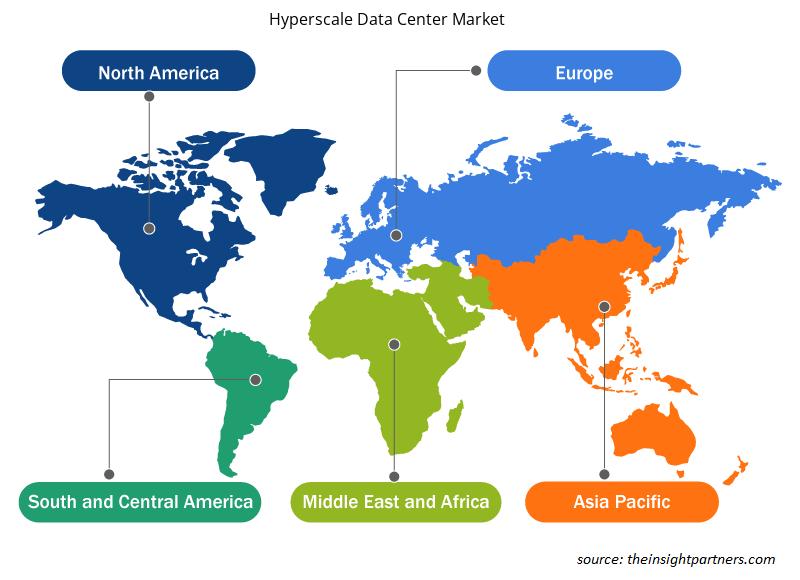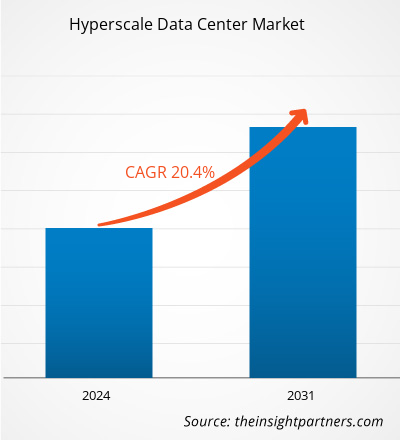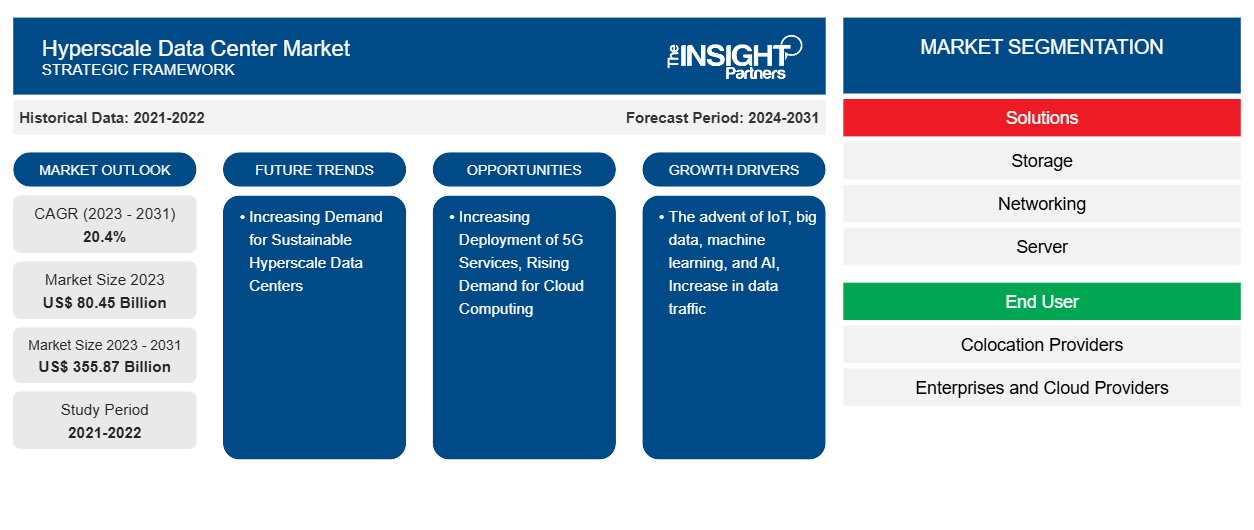Si prevede che la dimensione del mercato dei data center hyperscale raggiungerà i 355,87 miliardi di dollari entro il 2031, rispetto agli 80,45 miliardi di dollari del 2023. Si stima che il mercato registrerà un CAGR del 20,4% dal 2023 al 2031. È probabile che l'integrazione dell'IoT introduca tendenze di mercato chiave durante il periodo previsto.
Analisi di mercato dei data center iperscalabili
Il rapporto include prospettive di crescita dovute alle attuali tendenze del mercato dei data center iperscalabili e al loro impatto prevedibile durante il periodo di previsione. I data center iperscalabili stanno guadagnando una domanda significativa a causa delle loro caratteristiche come elevate capacità di elaborazione, archiviazione e larghezza di banda. Inoltre, la loro capacità di spostare enormi quantità di dati aumenta la loro popolarità. Questi data center sono convenienti, scalabili, più sicuri, più affidabili e meno dannosi per l'ambiente. I data center iperscalabili offrono servizi come archiviazione, gestione, backup e ripristino dei dati. Alimentano anche le comunità di gioco online, facilitano le transazioni ad alto volume e supportano l'implementazione di tecnologie all'avanguardia (come big data, apprendimento automatico e intelligenza artificiale). Di conseguenza, molte aziende e organizzazioni governative hanno iniziato a gestire i propri data center o ad assumere terze parti come Google e Amazon per l'archiviazione basata su cloud o persino il noleggio di server, il che continuerebbe ad alimentare la crescita del mercato dei data center iperscalabili durante il periodo di previsione.
Panoramica del mercato dei data center iperscalabili
I data center iperscalabili, con le loro enormi capacità di elaborazione, archiviazione e larghezza di banda, nonché il loro potenziale di gestire enormi volumi di trasferimenti di dati, hanno rivoluzionato il settore dei data center . Questo sviluppo ha cambiato completamente il modo in cui le aziende interagiscono e collaborano. Con l'adozione di politiche di lavoro da casa in varie organizzazioni in tutto il mondo dall'inizio della pandemia di COVID-19, la domanda di data center è in continuo aumento. Varie grandi organizzazioni come Facebook e Twitter e società di servizi finanziari e professionali hanno consentito ai propri dipendenti di lavorare da casa durante la pandemia, che è diventata una delle ragioni principali dell'aumento della domanda di data center iperscalabili in tutto il mondo.
Personalizza questo report in base alle tue esigenze
Riceverai la personalizzazione gratuita di qualsiasi report, comprese parti di questo report, o analisi a livello nazionale, pacchetto dati Excel, oltre a usufruire di grandi offerte e sconti per start-up e università
-
Scopri le principali tendenze di mercato in questo rapporto.Questo campione GRATUITO includerà analisi di dati che spaziano dalle tendenze di mercato alle stime e alle previsioni.
Driver e opportunità del mercato dei data center iperscalabili
L'avvento dell'IoT, dei Big Data, dell'apprendimento automatico e dell'intelligenza artificiale guida la crescita del mercato dei data center iperscalabili
Internet of Things (IoT), big data , machine learning e intelligenza artificiale (AI) sono alcune delle tecnologie che generano enormi volumi di dati, richiedono elaborazione a bassa latenza e richiedono risorse di elaborazione localizzate. IoTExpress Technologies Pvt. Ltd. ha previsto che il numero di dispositivi IoT supererà i 15 miliardi entro la fine del 2023 nell'Asia Pacifica, registrando un aumento del 55% rispetto al 2020. Inoltre, si prevede che questi dispositivi genereranno 79,4 zettabyte (ZB) di dati entro il 2025. L'IoT genera enormi volumi di dati che devono essere elaborati, archiviati e analizzati in tempo reale. I dispositivi IoT sono ampiamente utilizzati in tutta la regione, collegando vari oggetti fisici e consentendo la raccolta e la comunicazione dei dati. I data center posizionati ai margini della rete possono fornire potenza di elaborazione locale, archiviazione e capacità di analisi, riducendo i requisiti di latenza e larghezza di banda durante la trasmissione dei dati a un data center centralizzato. Può anche abilitare il processo decisionale in tempo reale e facilitare le distribuzioni IoT nei settori manifatturiero, sanitario, dei trasporti e delle smart city. Inoltre, l'elaborazione e l'analisi di set di dati così massicci richiedono una notevole potenza di calcolo e capacità di archiviazione. I data center iperscalabili offrono un'architettura scalabile e distribuita, consentendo alle organizzazioni di elaborare e analizzare big data. Inoltre, migliorano l'efficienza dell'elaborazione dei dati e abilitano l'analisi in tempo reale. Inoltre, gli algoritmi di apprendimento automatico e intelligenza artificiale richiedono risorse computazionali sostanziali per le attività di formazione e inferenza. I data center iperscalabili forniscono la potenza di elaborazione e le capacità di archiviazione necessarie per eseguire queste attività ad alta intensità di risorse nelle vicinanze della fonte dati. Le organizzazioni possono ridurre la latenza distribuendo data center iperscalabili all'edge. Ciò consente il processo decisionale in tempo reale, migliora le applicazioni basate sull'intelligenza artificiale e supporta casi d'uso quali veicoli autonomi, analisi video intelligenti, manutenzione predittiva e raccomandazioni personalizzate. Pertanto, l'avvento di tecnologie come IoT, apprendimento automatico, big data e intelligenza artificiale rafforza il mercato dei data center iperscalabili.
Crescente domanda di cloud computing
Il cloud computing offre un modo conveniente per gestire i dati, consentendo alle organizzazioni di archiviarli ed elaborarli in una posizione centralizzata senza investire in hardware e infrastrutture costosi. La crescente adozione di servizi di cloud computing spinge la domanda di servizi di data center hyperscale. L'integrazione delle tecnologie cloud con dispositivi e sistemi interconnessi ha portato a una maggiore preferenza per questi dispositivi, con conseguente crescente necessità di connettività di rete ad alta velocità e bassa latenza. I data center hyperscale offrono un ambiente hardware sicuro per archiviare e accedere ai dati, essenziale per supportare applicazioni IoT e basate su cloud, nonché per aiutare a risparmiare sui costi complessivi.
Con la crescente adozione di tecnologie basate su cloud, i principali attori del mercato dei data center hyperscale stanno creando nuove unità per le loro attività per rendere il cloud e l'infrastruttura digitale più accessibili. A settembre 2021, Vantage Data Centres ha aperto una nuova struttura nell'APAC con l'aiuto di due acquisizioni e una raccolta di capitale di 1,5 miliardi di dollari USA guidata da DigitalBridge Investment Management. Con questa espansione, la società ha iniziato a offrire servizi basati su cloud a Tokyo e Osaka (Giappone), Hong Kong (Cina), Kuala Lumpur (Malesia) e Melbourne (Australia). Il lancio di nuovi data center sta attirando più clienti per sfruttare i servizi di tecnologie avanzate. Pertanto, si prevede che la continua proliferazione di servizi basati su cloud rafforzerà la crescita del mercato dei data center hyperscale durante il periodo di previsione.
Analisi della segmentazione del rapporto di mercato dei data center iperscalabili
I segmenti chiave che hanno contribuito alla derivazione dell'analisi di mercato dei data center di grandi dimensioni sono: soluzione, utente finale e settore verticale.
- In base alla soluzione, il mercato è suddiviso in storage, networking, server, sicurezza e altri. Il segmento storage ha detenuto la quota di mercato più grande dei data center hyperscale nel 2023.
- In base all'utente finale, il mercato è segmentato in aziende, provider di colocation e provider cloud. Il segmento dei provider di colocation ha dominato il mercato nel 2023.
- In termini verticali, il mercato dei data center hyperscale è segmentato in BFSI, telecomunicazioni e IT, media e intrattenimento, governo e pubblico e altri. Il segmento BFSI ha dominato il mercato nel 2023.
Analisi della quota di mercato dei data center iperscalabili per area geografica
- Il mercato dei data center hyperscale è segmentato in cinque regioni principali: Nord America, Europa, Asia Pacific (APAC), Medio Oriente e Africa (MEA) e Sud e Centro America. Il Nord America ha dominato il mercato nel 2023, seguito da Europa e APAC.
- Il Nord America ha detenuto la quota di mercato più grande dei data center hyperscale nel 2023. I principali paesi nordamericani sono principalmente concentrati sul miglioramento dell'infrastruttura aziendale e sullo sviluppo di nuove tecnologie. Con i progressi nel settore aziendale vengono generati volumi significativi di dati e questi dati devono essere gestiti e archiviati in modo efficiente. La maggior parte delle aziende dominanti nel mercato dei data center ha sede in Nord America. Inoltre, le organizzazioni stanno progressivamente utilizzando servizi gestiti, colocation, servizi cloud e metodi ibridi aggiuntivi per introdurre nuovi prodotti e servizi, valutare modelli aziendali innovativi e stabilire connessioni più forti con la propria clientela. Pertanto, tutti i fattori di cui sopra stanno alimentando la crescita del mercato dei data center hyperscale nella regione.
Approfondimenti regionali sul mercato dei data center iperscalabili
Le tendenze regionali e i fattori che influenzano il mercato dei data center iperscalabili durante il periodo di previsione sono stati ampiamente spiegati dagli analisti di Insight Partners. Questa sezione discute anche i segmenti e la geografia del mercato dei data center iperscalabili in Nord America, Europa, Asia Pacifico, Medio Oriente e Africa e America meridionale e centrale.

- Ottieni i dati specifici regionali per il mercato dei data center iperscalabili
Ambito del rapporto di mercato sui data center iperscalabili
| Attributo del report | Dettagli |
|---|---|
| Dimensioni del mercato nel 2023 | 80,45 miliardi di dollari USA |
| Dimensioni del mercato entro il 2031 | 355,87 miliardi di dollari USA |
| CAGR globale (2023-2031) | 20,4% |
| Dati storici | 2021-2022 |
| Periodo di previsione | 2024-2031 |
| Segmenti coperti |
Per Soluzioni
|
| Regioni e Paesi coperti |
America del Nord
|
| Leader di mercato e profili aziendali chiave |
|
Attori del mercato dei data center iperscalabili Densità: comprendere il suo impatto sulle dinamiche aziendali
Il mercato dei data center iperscalabili sta crescendo rapidamente, spinto dalla crescente domanda degli utenti finali dovuta a fattori quali l'evoluzione delle preferenze dei consumatori, i progressi tecnologici e una maggiore consapevolezza dei vantaggi del prodotto. Con l'aumento della domanda, le aziende stanno ampliando le loro offerte, innovando per soddisfare le esigenze dei consumatori e capitalizzando sulle tendenze emergenti, il che alimenta ulteriormente la crescita del mercato.
La densità degli operatori di mercato si riferisce alla distribuzione di aziende o società che operano in un particolare mercato o settore. Indica quanti concorrenti (operatori di mercato) sono presenti in un dato spazio di mercato in relazione alle sue dimensioni o al valore di mercato totale.
Le principali aziende che operano nel mercato dei data center iperscalabili sono:
- ABB Ltd
- Dell Inc
- EdgeConneX Inc
- Cisco Systems Inc
- Società internazionale di macchine per il commercio
- Fujitsu Ltd
Disclaimer : le aziende elencate sopra non sono classificate secondo un ordine particolare.

- Ottieni una panoramica dei principali attori del mercato dei data center iperscalabili
Notizie e sviluppi recenti sul mercato dei data center iperscalabili
Il mercato dei data center hyperscale viene valutato raccogliendo dati qualitativi e quantitativi dopo la ricerca primaria e secondaria, che include importanti pubblicazioni aziendali, dati associativi e database. Di seguito sono elencati alcuni degli sviluppi nel mercato dei data center hyperscale:
- Digital Realty, il più grande fornitore globale di soluzioni cloud- e carrier-neutral data center, colocation e interconnessione, e Blackstone Inc. hanno annunciato che i fondi affiliati a Blackstone guidati da Infrastructure, Real Estate e Tactical Opportunities hanno concordato di costituire una joint venture con Digital Realty per sviluppare quattro campus di data center hyperscale in tre aree metropolitane in due continenti. Si prevede che gli sviluppi supporteranno circa 500 megawatt (MW) di carico IT totale una volta completata la costruzione di tutti i campus.
(Fonte: Digital Realty, Comunicato stampa, dicembre 2023)
- IXAfrica Data Centres ha lanciato il primo e più grande Data Center AI-ready hyperscale dell'Africa orientale a Nairobi per attrarre clienti globali hypercloud. Schneider Electric sta supportando il lancio fornendo un power train altamente resiliente che include trasformatori, quadri di commutazione MT e BT, distribuzione di potenza e backup UPS e soluzioni di gestione EcoStruxure.
(Fonte: Schneider Electric, Comunicato stampa, luglio 2024)
Copertura e risultati del rapporto sul mercato dei data center iperscalabili
"Dimensioni e previsioni del mercato dei data center iperscalabili (2021-2031)" fornisce un'analisi dettagliata del mercato che copre le aree menzionate di seguito:
- Dimensioni e previsioni del mercato dei data center iperscalari a livello globale, regionale e nazionale per tutti i segmenti di mercato chiave coperti dall'ambito
- Tendenze del mercato dei data center iperscalabili e dinamiche di mercato come driver, vincoli e opportunità chiave
- Analisi PEST e SWOT dettagliate
- Analisi di mercato dei data center iperscalabili che copre le principali tendenze di mercato, il quadro globale e regionale, i principali attori, le normative e i recenti sviluppi del mercato
- Analisi del panorama industriale e della concorrenza che copre la concentrazione del mercato, l'analisi della mappa di calore, i principali attori e gli sviluppi recenti per il mercato dei data center iperscalabili
- Profili aziendali dettagliati
- Analisi storica (2 anni), anno base, previsione (7 anni) con CAGR
- Analisi PEST e SWOT
- Valore/volume delle dimensioni del mercato - Globale, Regionale, Nazionale
- Industria e panorama competitivo
- Set di dati Excel
Report recenti
Rapporti correlati
Testimonianze
Motivo dell'acquisto
- Processo decisionale informato
- Comprensione delle dinamiche di mercato
- Analisi competitiva
- Analisi dei clienti
- Previsioni di mercato
- Mitigazione del rischio
- Pianificazione strategica
- Giustificazione degli investimenti
- Identificazione dei mercati emergenti
- Miglioramento delle strategie di marketing
- Aumento dell'efficienza operativa
- Allineamento alle tendenze normative























 Ottieni un campione gratuito per - Mercato dei data center iperscalabili
Ottieni un campione gratuito per - Mercato dei data center iperscalabili